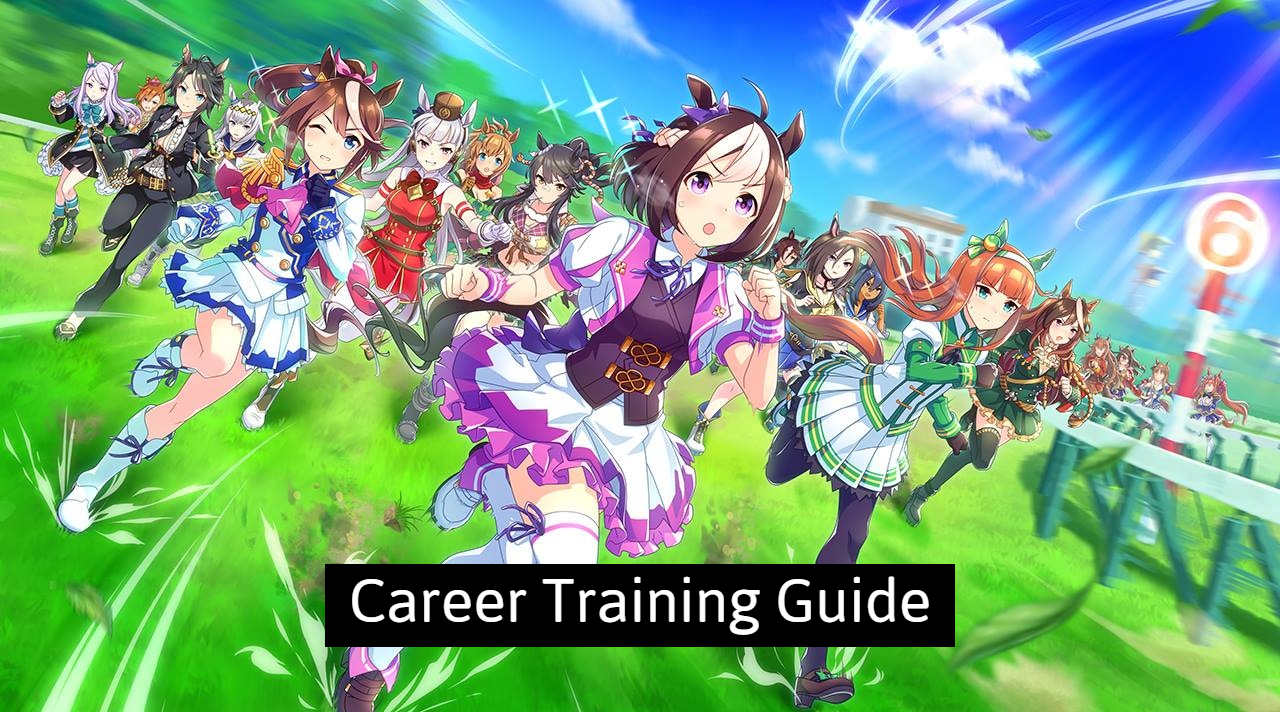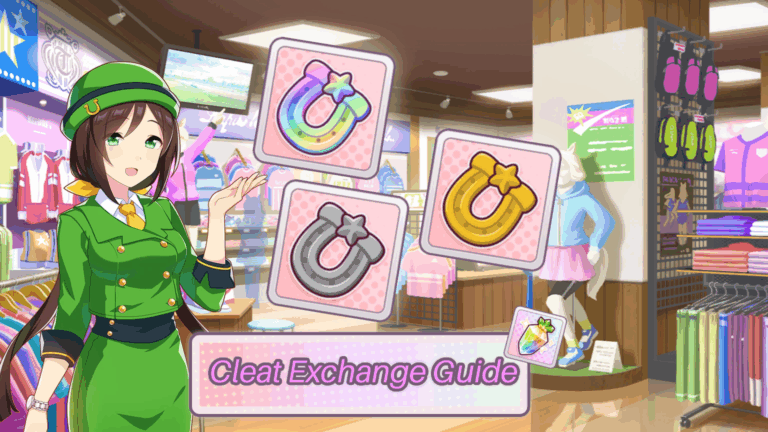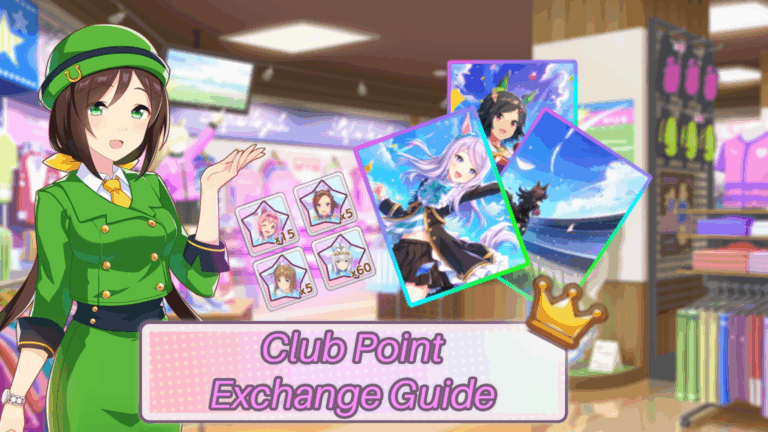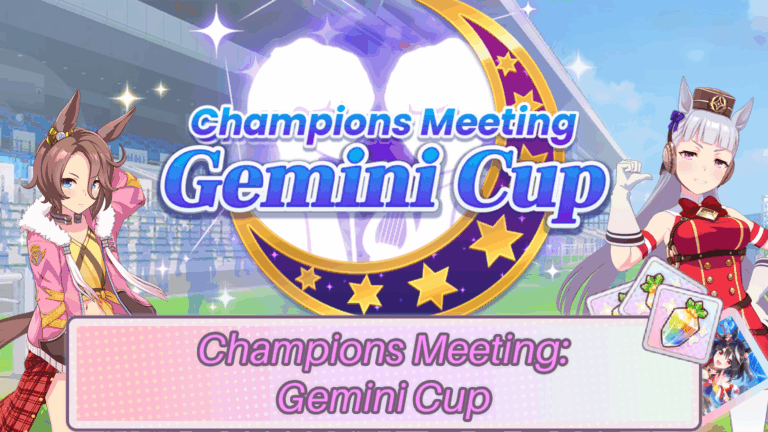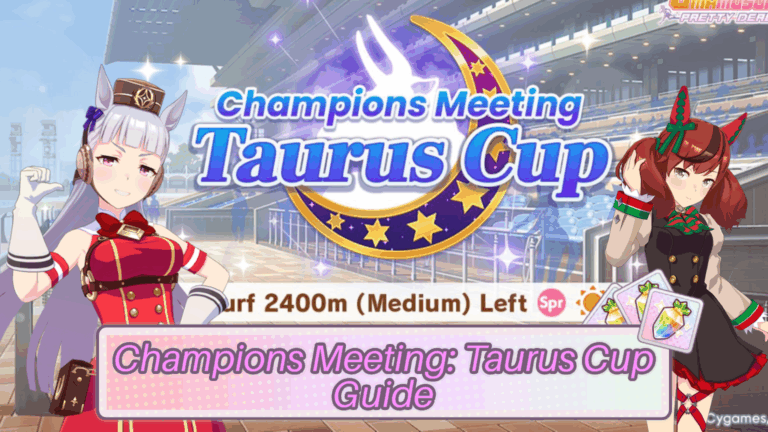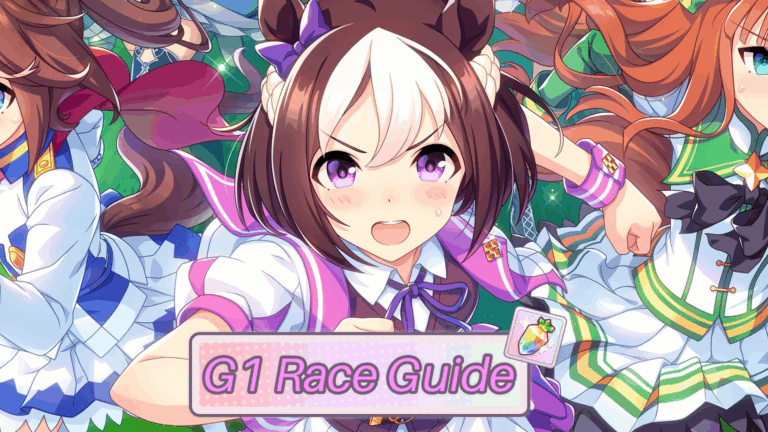What is Career Training?
Events or scenarios in career mode are the main form of gameplay. This is where you can raise an Umamusume's stats and, which allows them to achieve the career objectives laid out in their career info. Once a scenario is completed, the umamusume trained will become a veteran, who can then be used in Team Trials and daily races - a scenario does not need to be fully successful in order to create a veteran umamusume.
Scenario
A scenario is a story path with specific goals to achieve. The trainer will work with the trainee over 3 years to raise her stats and help her compete in races. Currently, the only available scenario at launch is the URA Finale - the end goal of the scenario is to win said event.
Each trainee will generally have a different path and different races they need to place in to achieve their goals. If a trainer fails a goal, the career will end prematurely - this still produces a veteran umamusume, however.
Scenarios take place over 3 years in-game.

Stats and Aptitudes
When selecting an umamusume to train, you can view their base stats and their different aptitudes. These will vary based on the girl, and affects the kind of races they can perform well in. These go from G up to S.
An umamusume's base aptitudes will only be as high as A rank. Sparks from legacy Umamusumes relating to different aptitudes can raise an A rank aptitude to an S rank through an inspiration event.
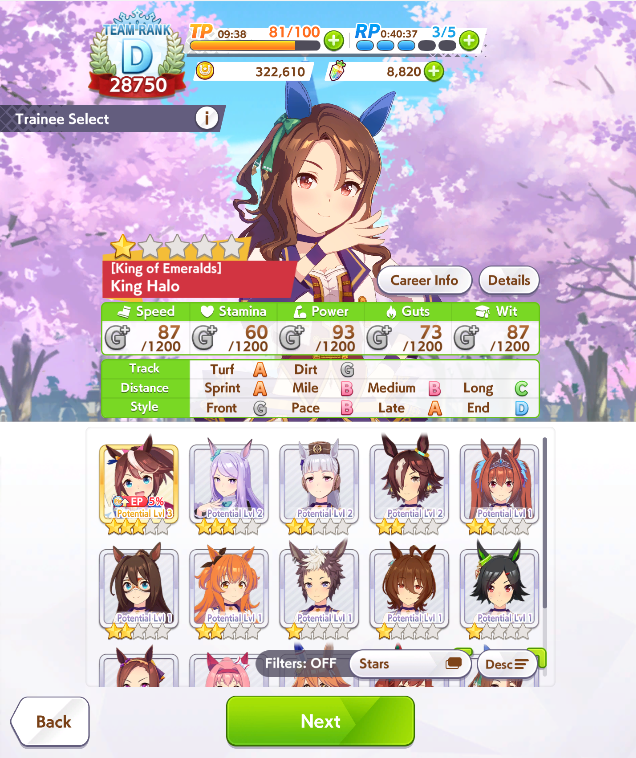
Aptitudes
Track
This is the type of surface being run on - all umamusumes will be either a Turf or Dirt runner.
Distance
This affects the category of race the umamusume is suited to run in. There are four distance categories, each depending on the length of the race - sprint races are 1000m-1400m, mile races are 1500m-1800m, medium races are 2000m-2400m and long races are 2500m-3600m. Each category of race prioritizes different stats.
Style
This is the running strategy the umamusume will use during a race - this can be set prior to the beginning of a race, and affects the different skills that are activated. The four running styles are Front Runner, Pace Chaser, Late Surger and End Closer.
Penalties/Bonuses
Aptitudes in career can result in either penalties or bonuses depending on the rating. An aptitude of A is the baseline, and provides no penalties or bonuses - a B ranking results in a 10% penalty, going down to 90% for a G. The B aptitude penalty can generally be overcome by training the affected stat more. S is the only aptitude that provides a bonus - an umamusume having an S aptitude results in a 5% bonus to the related stat.
Distance aptitude affects speed, whereas track aptitude affects power (acceleration). These two are most important to raise if they are too low for the umamusume's career goal races - running style affects wit (skill activation rate), so can be mostly ignored.
Stats
Speed
This determines how fast the umamusume can run. Speed is most important for sprinters, however it should be the primary stat raised for most girls as it has the most impact on the overall race outcome.
Stamina
This affects how long an umamusume can maintain her energy during the race, and therefore how long she can run at a high speed. This is mainly important for medium and long runs (1800m-3600m): the longer the run, the more important of a stat this becomes.
Power
This determines acceleration during a race, as well as how good an umamusume is at corner taking and overtaking other racers. Power is usually raised alongside speed.
Guts
Usually the most neglected stat. This affects a racer's ability to keep running after stamina is depleted.
Wits
This impacts how likely an umamusume is to activate acquired skills during a race. Generally, higher wits means she will activate skills more frequently, which is useful if you have a lot of good skills. Higher wits will also mean an umamusume is less likely to be inflicted with Rushed - this is a debuff where a horse girl will panic and overexert herself by running too far too early. This causes her to run out of stamina prematurely and therefore lose speed.
Legacies and Inspiration
When beginning a career scenario, you can select two legacies for your umamusume. These legacies can then inspire your trainee during the two mid-career inspiration events - this is where they pass on sparks to the trainee, increasing their stats and/or aptitude for a certain type of race.
Sparks are gained when a career scenario is completed - these can be from 1 to 3 stars and for a variety of different races, skills or statistics. A legacy with a 3 star spark is best.
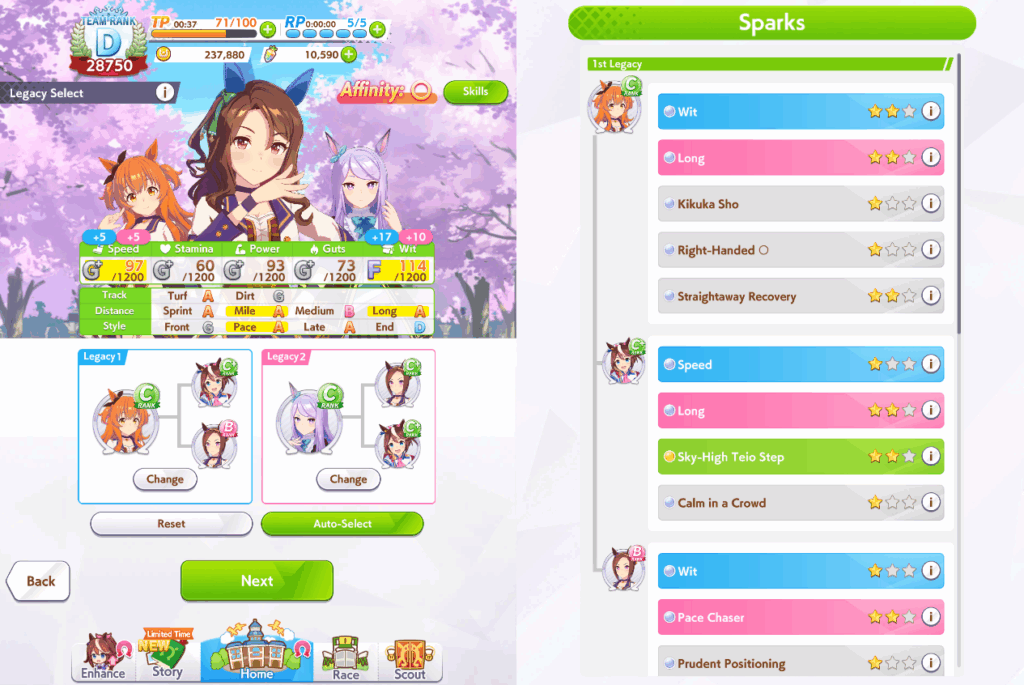
When selecting a legacy, you can view their affinity with the trainee - this goes in order of lowest (indicated by a triangle △) to higher affinity (single circle ◯ -> dual circle ⦾). Legacies which have higher affinity with the trainee will be more likely to pass on their sparks.
Support Cards
Before starting a career scenario, a deck of support cards must be created - 5 from your own account and 1 borrowed from a friend. These are seperated by stat, and go up in rarity from R to SSR. However, don't be fooled into thinking only SSRs are needed - a fully limit broken SR card can perform much better than a 0LB SSR.
Support cards increase initial stats, and can also trigger specific scenarios during training that further increase stats, mood or energy. They can also provide useful skills, e.g. Super Creek's Swinging Maestro.
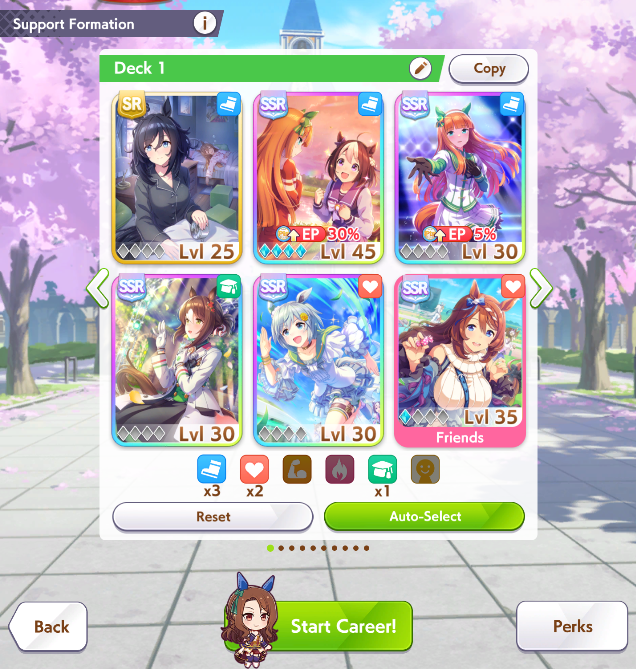
Mechanics/Career
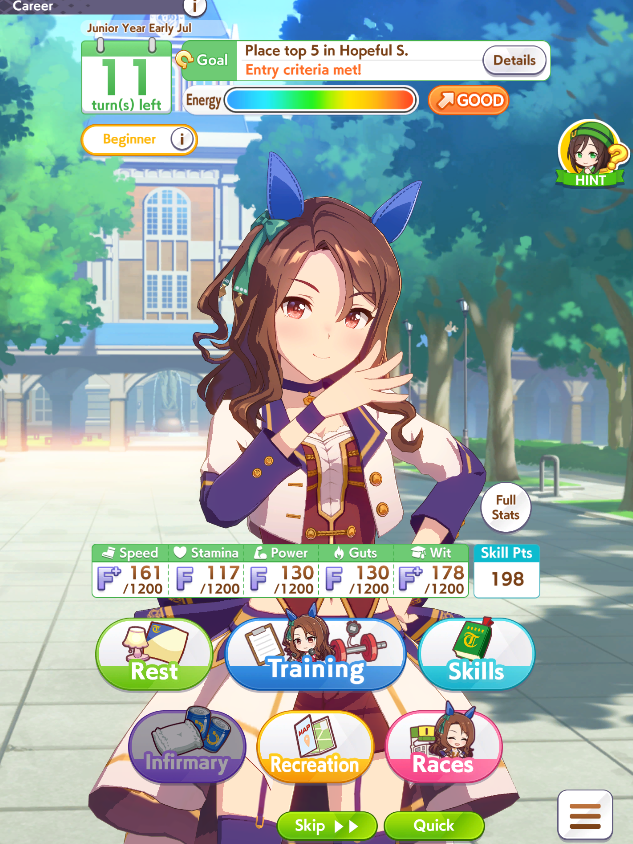
Once a career has been started, this interface will be shown, which contains various different actions and information about the career path.
- Remaining turns is in the upper left. This shows the number of actions remaining until the next goal/race - career scenarios are split into 72 turns total.
- The next goal is along the top. This will show the place requirement and name of the race - it may show the number of fans required instead, if the goal is not a race.
- Energy and mood are below the goal. Mood has 5 possible stages and affects how well a trainee performs in training and races - this should always be at great (highest) before races and summer camp. energy depletes after training actions or non-required races. Low energy can lead to failed training or a trainee developing negative conditions.
Stats and player actions are along the bottom half of the screen. Trainers can also view the aptitudes and skills of a trainee by clicking the 'Full Stats' button next to the bar with numbers.
- Rest recovers energy for the trainee. This uses up one full turn, so ideally energy should be gained from support card scenarios during training where possible.
- Recreation raises the mood of a trainee through various events. It is also possible to trigger an arcade event, where a minigame to catch cuties (plushies) in a claw machine is played. This further raises mood. Like rest, recreation uses up one full turn without being able to train, so mood should ideally be raised through support card scenarios or other events during training.
- Infirmary is unlocked when a trainee develops a negative condition. Ideally, this should be visited as soon as possible after acquiring the condition, as negative conditions can affect performance in races and training. This takes up one full turn.
- Skills is where you can buy new skills, using skill points. Some skills are exclusively effective on certain running styles or race distances, so be careful to only get skills that are compatible with your trainee.
- Races shows available races to partake in. These will show the distance, track type and grade, as well as number of fans gained from 1st place - races suited to your trainee will have the track and distance highlighted in gold. During a race day, skills and races will be the only tabs available, and races other than the target will be locked.
Training
When training a specific stat, it will increase by a certain amount - this is dependent on factors like the level of training and whether it is friendship training or not.
When a stat is selected for training, you can also view how much energy it consumes and the failure rate - the rate will increase as energy and mood drop. Failed training will lower stats and may also develop negative conditions, as well as wasting a turn. It is generally recommended to avoid training when the rate is high, and to rest instead.
Wit training is the only kind that does not consume energy and instead restores a small amount.
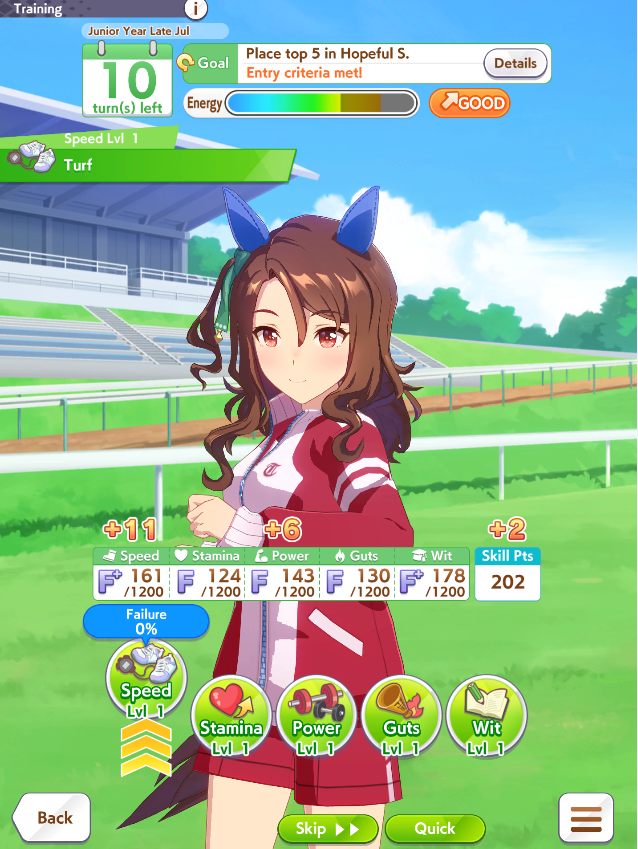

During training, icons of umamusumes featured in your support card deck will be visible on the top right. These will have a friendship gauge - when the gauge reaches orange, it is possible to activate friendship training. This results in increased stats from that training. Friendship training is indicated by a rainbow outline on the training icon. The gauge is levelled up by engaging in successful training when the icons are present.
Support cards present in a training type also have the possibility to trigger specific scenarios. These may increase stats, recover energy, or allow the trainee to learn specific skills.
Running Style Recommendation
Front Runner is a good style for training parent legacies - it's easier to win with this, as the chances of your trainee getting blocked are less. However, if going with front runner for longer distance races, stamina needs to be higher to ensure your trainee does not run out of endurance and slow down.
Late Surger can be used if you are struggling to get stamina high enough - however they have a higher chance to get blocked by the often lower stat runners in career, as well as have a late start or become rushed. To counteract this, train wits a bit higher if you plan to use late surger.
Some umamusume unique skills have conditions that may make some running styles inefficient. For example, Gold Ship's unique skill requires her to be in the second half of the pack to activate, therefore front runner would not suit her; check if your trainee's unique skill has any requirements for position before using a specific running style.
